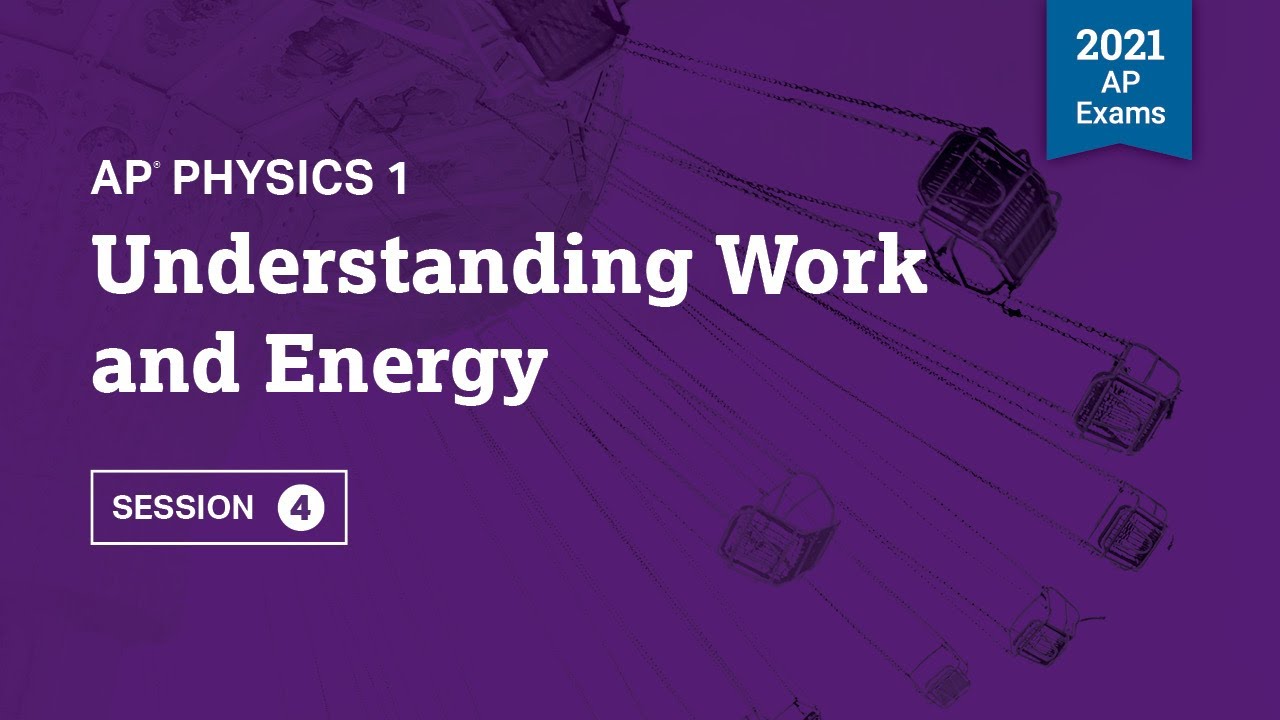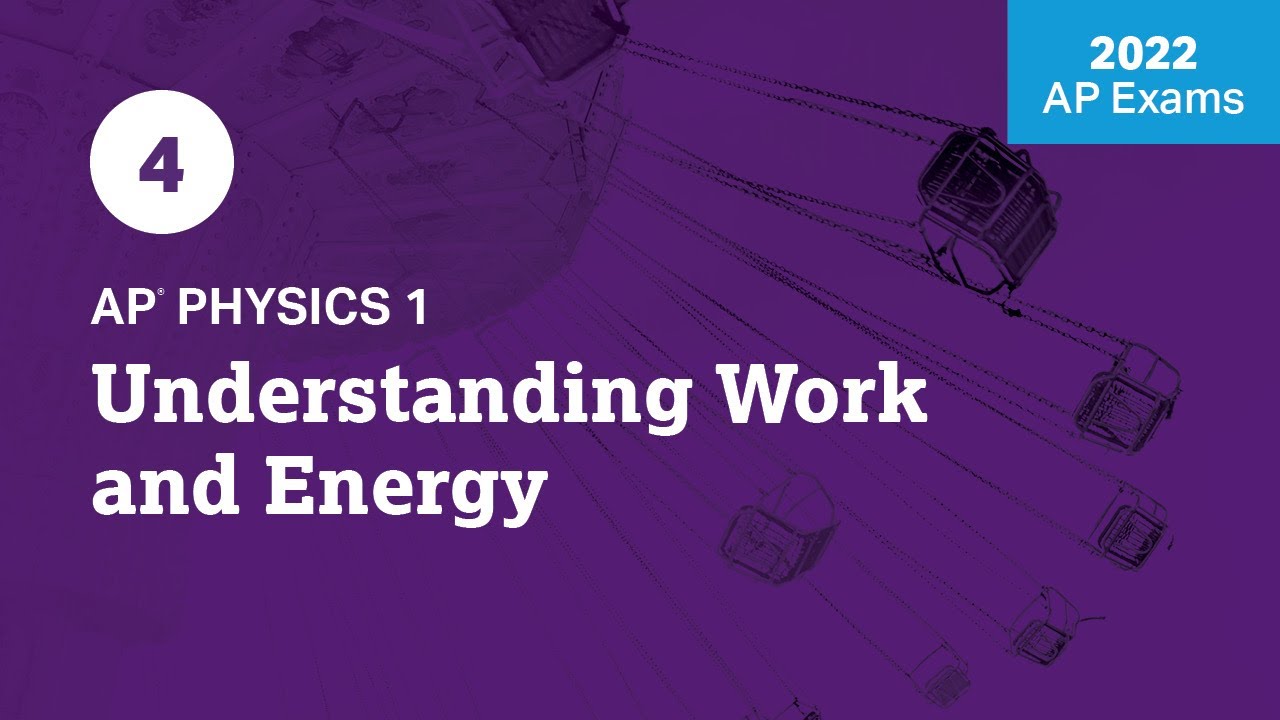1 | MCQ | Practice Sessions | AP Physics 1
TLDRIn this AP Daily practice session, Kristin Gonzalez-Vega from Centennial High School in Texas guides students through multiple-choice questions on physics. She emphasizes the importance of identifying the system under consideration and understanding the types of energy involved, such as kinetic, potential, and frictional forces. Gonzalez-Vega provides strategies for solving problems, including the use of energy bar charts (LOL diagrams) and considering external forces' impact on the system. The session aims to improve students' problem-solving skills and prepare them for the AP Physics exam.
Takeaways
- 📝 Start by identifying the key elements of the problem, such as the system's boundaries and the types of energy involved.
- 🔍 When dealing with complex problems, focus on extracting important information and ignoring the irrelevant details.
- 📊 For energy-related questions, consider whether friction and air resistance are significant factors based on the problem statement.
- 🌐 Determine the system under consideration to understand which forces and energies are relevant to the problem.
- 🔄 Use energy bar charts or LOL diagrams to visualize and solve problems involving energy transformations.
- 📈 Pay attention to the initial and final conditions of the system to analyze changes in energy.
- 🚫 Be cautious of external forces and their impact on the system; they can change energy and momentum.
- 🤹♂️ Practice problems by pausing the video and attempting to answer questions independently before discussing them.
- 📐 In problems with inclined planes, consider the role of gravitational potential energy and its conversion to kinetic energy.
- 🔄 For collisions, consider the conservation of momentum and the transfer of energy between objects.
- 📈 In systems with no external forces, the total mechanical energy remains constant, but individual forms of energy may change.
Q & A
What is the main focus of the AP Daily practice sessions mentioned in the transcript?
-The main focus of the AP Daily practice sessions is to provide strategies and tips for answering multiple-choice questions, with an emphasis on understanding and applying concepts related to energy and systems in physics problems.
What materials are suggested for participants to have during these practice sessions?
-Participants are suggested to have paper, a formula chart, something to write with, and a calculator. Although not all sessions will require set calculations, having a calculator handy is recommended for future sessions.
How does Kristin Gonzalez-Vega suggest approaching a complex physics problem?
-Kristin Gonzalez-Vega suggests pausing the video, reading through the problem, trying to answer it on your own, and then comparing your answer with the discussion provided in the session. She also emphasizes identifying the key components of the problem, such as the system under consideration and the types of energy involved.
What does 'non-negligible' mean in the context of frictional forces in the first physics problem discussed?
-In the context of the first physics problem, 'non-negligible' means that the frictional forces are significant and cannot be ignored. This is a hint that friction is present and will affect the outcome of the problem.
How does the concept of systems help in solving energy-related physics problems?
-The concept of systems is crucial in energy-related physics problems because it helps to define the scope of the analysis. By identifying what is included in the system (such as the block, the spring, and the Earth), one can determine which types of energy are relevant (like kinetic, potential, or elastic energy) and which forces or interactions can affect the system's energy (like friction or air resistance).
What is an 'energy bar chart' or 'LOL diagram' and how is it used?
-An 'energy bar chart' or 'LOL diagram' is a visual tool used to represent the energy changes in a system from an initial condition to a final condition. It involves drawing a line labeled 'LOL' and placing the initial energy conditions on the left side and the final energy conditions on the right side. The diagram helps to visualize the transformation of energy types and to understand the work done by or on the system.
Why does the mechanical energy of the system consisting of the block not change in the second problem?
-The mechanical energy of the system consisting of the block does not change because it starts and ends at rest, meaning there is no gain or loss of kinetic energy. The potential energy due to the block's height change is converted into kinetic energy as it slides down, but since there is no friction or other external forces doing work, the total mechanical energy remains constant.
How does the mass of the block affect the horizontal distance it travels in the second problem?
-The mass of the block does not affect the horizontal distance it travels in the second problem. This is because the kinetic energy equation (which determines the velocity of the block at the bottom of the ramp) does not depend on the mass. The mass cancels out in the energy conversion from gravitational potential energy to kinetic energy, so the block will have the same velocity regardless of its mass.
What principle is involved in the third problem regarding the clay ball and the block?
-The third problem involves the principle of conservation of momentum. When the clay ball collides with and sticks to the block, the total momentum of the clay-block system must remain constant, assuming no external forces are acting on the system.
Why does the total mechanical energy of the clay-block system decrease when the Earth is not considered part of the system?
-When the Earth is not considered part of the system, the total mechanical energy decreases because the Earth can do work on the system. The work done by the Earth (such as when gravity pulls the system downward) results in a transformation of mechanical energy into other forms, like heat or sound, leading to a net loss in mechanical energy.
What is the key takeaway from the practice session regarding the approach to physics problems?
-The key takeaway is to always identify what is included in your system and what types of energy are relevant. It's also important to consider external forces or elements that are not part of the system, as they can do work and affect the energy within the system. This approach helps in understanding and solving physics problems more effectively.
Outlines
📚 Introduction to AP Daily Practice and Strategies for Multiple-Choice Questions
Kristin Gonzalez-Vega introduces the AP Daily practice sessions, highlighting the importance of understanding multiple-choice questions and providing strategies for tackling them. She emphasizes the need to identify key information and offers tips on how to achieve the best possible score. Gonzalez-Vega also mentions the availability of practice problems in PDF form and suggests that students prepare paper, a formula chart, and a calculator for the sessions, even though calculations won't be covered in the current session.
🔍 Analyzing a Complicated Physics Problem
The session delves into a complex physics problem involving a block compressing a spring on an inclined plane. Gonzalez-Vega advises students to focus on the essential elements of the problem, such as the presence of friction and the system's energy transformations. She explains how to determine the correct answer by analyzing the system's boundaries, the types of energy involved, and the impact of external forces. The explanation includes a discussion on the conservation of mechanical energy and the significance of friction in energy calculations.
🚀 Understanding Energy Conservation in Different Systems
Gonzalez-Vega continues the discussion on energy by examining a problem where a block slides down a ramp and into the air. She clarifies the concept of energy conservation in systems with and without friction. The explanation includes the calculation of the block's velocity and the factors affecting the mechanical energy of the system. Gonzalez-Vega also introduces the concept of an energy bar chart (LOL diagram) to visualize the energy changes in a system, emphasizing the importance of identifying the system's boundaries and the types of energy involved.
🤹♀️ Applying the Principles of Momentum and Energy in Collision Scenarios
In the final part of the session, Gonzalez-Vega addresses a problem involving a clay ball colliding with a block attached to a string. She explains how to determine which quantities remain constant after the collision and when the block reaches its maximum height. The discussion covers the principles of linear and angular momentum, as well as the conservation of mechanical energy in systems with and without external forces like the Earth's gravitational pull. Gonzalez-Vega reiterates the importance of identifying the system's boundaries and the potential energy types it can store, and the impact of external forces on the system's energy.
Mindmap
Keywords
💡Multiple-choice questions
💡Strategies
💡Energy
💡Friction
💡Systems
💡Mechanical energy
💡Gravitational potential energy
💡Kinetic energy
💡Energy conservation
💡Work
💡Energy bar chart
Highlights
Kristin Gonzalez-Vega introduces the session focused on multiple-choice questions and strategies for the AP Daily practice.
The session provides problems in PDF form for download, and suggests having paper, a formula chart, and a calculator ready for practice.
The first question involves a block compressing a spring on an incline and the importance of identifying the system and types of energy involved.
Frictional forces are considered non-negligible in the problem, indicating the presence of friction which affects the energy of the system.
The importance of determining the correct system for energy analysis is emphasized, as it affects the types of energy storage and external forces.
The correct answers for the first question are B and C, which relate to the mechanical energy of the block and the block-Earth system.
An energy bar chart or LOL diagram is recommended for visualizing energy changes in a system.
The second question focuses on the relationship between the height from which the block is released and the distance it travels.
The absence of friction in the second problem means that mechanical energy is conserved within the block-Earth system.
The third question involves a collision between a clay ball and a block, highlighting the conservation of linear momentum and angular momentum principles.
The total mechanical energy of the clay-block system decreases due to the absence of the Earth in the system, leading to energy loss.
The key takeaway is to always identify what is within the system and what types of energy are involved for accurate analysis.
External forces can do work on a system if they have a component parallel to the object's displacement.
The session concludes with an encouragement for viewers to return for more practice on systems and energy in AP Daily practice.
Transcripts
Browse More Related Video

2021 Live Review 4 | AP Physics 1 | Understanding Work and Energy

2 | FRQ (Question 4/5: Short Answer) | Practice Sessions | AP Physics 1

3 | FRQ (Question 1: Experimental Design) | Practice Sessions | AP Physics 1

6 | FRQ (Question 2: Qualitative/Quantitative Translation) | Practice Sessions | AP Physics 1

2021 Live Review 5 | AP Physics 1 | Impulse and Conservation of Momentum

2022 Live Review 4 | AP Physics 1 | Understanding Work and Energy
5.0 / 5 (0 votes)
Thanks for rating: